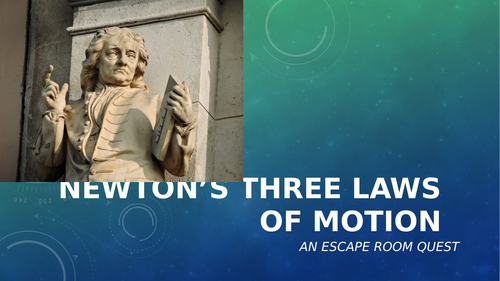

After your initial preparation, the beauty of this activity is that it is entirely student-driven! They will know whether they got the correct answer to the clue because there is a self-correcting code to crack. Everyone participates, because when one group finishes before the others, the rules of the quest include the instruction to split up and help another group finish.
The instructions below are for 6 groups of students. If you have fewer groups, follow the directions in parentheses.
Materials needed:
Construction paper: Yellow, Red, and Blue
18 business-size envelopes (15 for 5 groups, 12 for 4 groups)
3 small boxes (shoe boxes are perfect)
Copy paper
3 markers
Adhesive tape
Assorted prizes
Preparation:
1. Print three lock images. It’s okay if you don’t have a color printer – simply print in black and white and attach to the colored construction paper.
2. Designate each box as Newton’s First Law (blue), Second Law (yellow), and Third Law (red). Attach the prepared lock images to each box.
3. Cut eighteen 3” x 5” rectangles from the yellow, red, and blue construction paper. Attach to the envelopes: 6 yellow, 6 red, and 6 blue. (15 for 5 groups, 12 for 4 groups)
4. Print the Clue Sheet for each combination. Insert it in the designated color envelope.
5. Before the students enter the room, hide the envelopes.
6. Show the PowerPoint.
7. At the BEGIN slide, let the students search for the envelopes. Remind them that only one person from a group may be up and searching. Each time they look for an envelope, a different group member searches for a different color.
8. When the students get their combination number, one person will enter it on the box locks. This activity has self-correcting answers! If they don’t get a number as an answer, they will know that it is incorrect! If you have fewer than six groups, simply place a random number in the spaces you don’t use.
9. When one group finishes with three different color envelopes, they are to split up and help other groups.
10. When all the groups have finished, go over all the examples for each of Newton’s Laws of Motion. Either let the students present their findings, or you can show the finished products to the class, elaborating on each.
11. Show the reward slides on the PowerPoint. Some examples of rewards include homework passes, extra points on tests, dollar store goodies, stickers, etc.
12. When the activity is over, post the examples of each law next to the locks so everyone can see each other’s examples every day for a while!
The instructions below are for 6 groups of students. If you have fewer groups, follow the directions in parentheses.
Materials needed:
Construction paper: Yellow, Red, and Blue
18 business-size envelopes (15 for 5 groups, 12 for 4 groups)
3 small boxes (shoe boxes are perfect)
Copy paper
3 markers
Adhesive tape
Assorted prizes
Preparation:
1. Print three lock images. It’s okay if you don’t have a color printer – simply print in black and white and attach to the colored construction paper.
2. Designate each box as Newton’s First Law (blue), Second Law (yellow), and Third Law (red). Attach the prepared lock images to each box.
3. Cut eighteen 3” x 5” rectangles from the yellow, red, and blue construction paper. Attach to the envelopes: 6 yellow, 6 red, and 6 blue. (15 for 5 groups, 12 for 4 groups)
4. Print the Clue Sheet for each combination. Insert it in the designated color envelope.
5. Before the students enter the room, hide the envelopes.
6. Show the PowerPoint.
7. At the BEGIN slide, let the students search for the envelopes. Remind them that only one person from a group may be up and searching. Each time they look for an envelope, a different group member searches for a different color.
8. When the students get their combination number, one person will enter it on the box locks. This activity has self-correcting answers! If they don’t get a number as an answer, they will know that it is incorrect! If you have fewer than six groups, simply place a random number in the spaces you don’t use.
9. When one group finishes with three different color envelopes, they are to split up and help other groups.
10. When all the groups have finished, go over all the examples for each of Newton’s Laws of Motion. Either let the students present their findings, or you can show the finished products to the class, elaborating on each.
11. Show the reward slides on the PowerPoint. Some examples of rewards include homework passes, extra points on tests, dollar store goodies, stickers, etc.
12. When the activity is over, post the examples of each law next to the locks so everyone can see each other’s examples every day for a while!
Something went wrong, please try again later.
This resource hasn't been reviewed yet
To ensure quality for our reviews, only customers who have purchased this resource can review it
Report this resourceto let us know if it violates our terms and conditions.
Our customer service team will review your report and will be in touch.
$10.00